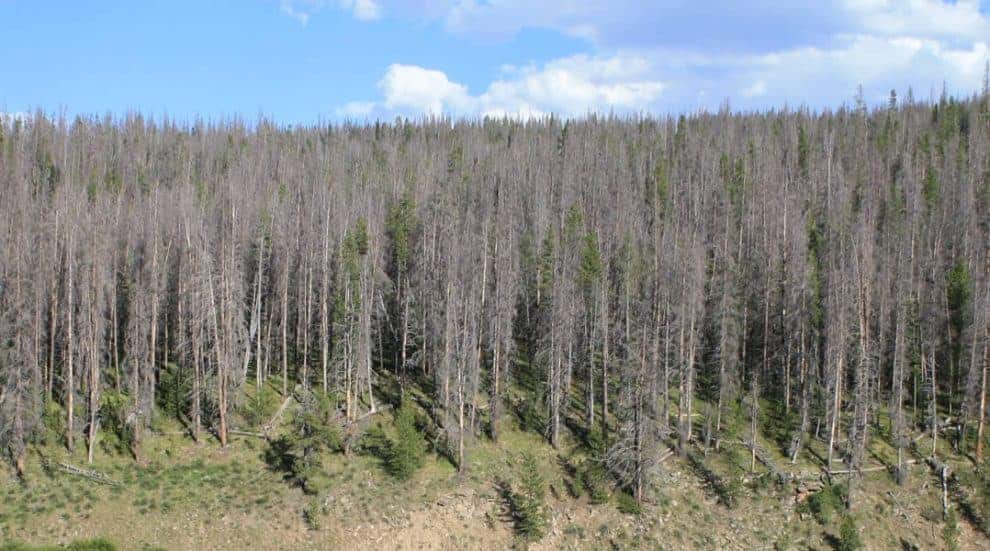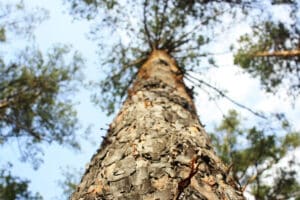If you’ve spent any time in the West, I’m sure you’ve seen them – hillsides that were once home to large swaths of lush, green forests transformed into wastelands of reddish-gray dead timber. In certain National Forests, it’s not uncommon to drive for dozens of miles through areas where the vast majority of the trees have been killed.
The culprits responsible for most of this arboreal carnage are tiny insects collectively known as bark beetles, and they’re amazingly efficient at infecting and killing large stands of pines and spruces. The decimating effect of these beetles is one of the major ecological issues facing the Rocky Mountain region, particularly for buyers and sellers of working and recreational ranches.
When discussing beetle infestation with landowners and ranch buyers, I’ve found that many falsely assume that stands of “beetle-killed” trees are significantly more flammable than healthy trees, therefore posing a greater risk of wildfire. While it seems reasonable to think that a hillside of dead timber is more likely to burn than a live forest, recent scientific research tells a different story.
There’s a growing consensus among scientists that a forest of dead, beetle-killed trees is no more flammable than a healthy, thriving forest:
“Such ongoing [beetle] outbreaks have led to widespread public concern about increased fire risk; however, outbreaks of mountain pine beetle and spruce beetle do not appear to substantially increase the risk of subsequent fire under most conditions.” – Excerpt from “Do Bark Beetle Outbreaks Increase Wildfire Risks in the Central U.S. Rocky Mountains? Implications from Recent Research,” Black et al. 2013
To understand why dead trees are no more flammable than live ones, consider the following: Two to three years after a forest is killed by beetles, all the foliage falls off the trees, leaving stands of bare, needleless trees- basically just dry, large logs protruding from the ground. The lack of needles reduces the forest canopy’s “bulk density” (i.e. the amount of fuel, alive or dead, in the trees’ upper branches), which has two effects on a forest’s flammability: 1) It reduces “ladder fuel,” which allows a surface fire to climb from the forest floor up a tree and transform into a more severe crown fire, and 2) it creates gaps between trees’ canopies that reduce the ability of crown fires to spread from tree to tree. Any increase in the forest’s flammability due to dry timber is counterbalanced by the decrease in total fuel given the lack of foliage.
(It is worth noting, however, that dead trees that have not yet lost all their needles are definitely more flammable and more of a wildfire risk. They’re the worst of both worlds – dry timber with a large amount of extra-flammable bulk density.)
Examining forest fire records helps to drive home the point. Summer of 2002 was a notoriously tough season for wildfires in Colorado. Eight of the state’s top twenty largest wildfires on record occurred during that hot, dry summer, with hundreds of thousands of acres burned to the ground. After compiling and analyzing the fire data from that summer, researchers concluded that beetle-killed forests fared no worse than live forests.
While there are no shortage of troubling effects resulting from bark beetle infestation (flooding, erosion, visual impacts, etc.), increased forest fire risk should not be a significant cause for concern – the data and research indicate that there is no clear link between beetle-killed forests and a greater chance of wildfire.
For more information on bark beetles and wildfire risks, please see the following resources:
- Do Bark Beetle Outbreaks Increase Wildfire Risks in the Central U.S. Rocky Mountains? Implications from Recent Research
- Recent Forest Insect Outbreaks and Fire Risk in Colorado Forests: A Brief Synthesis of Relevant Research
- The Influence of Mountain Pine Beetle Outbreaks and Drought on Severe Wildfires in Northwestern Colorado and Southern Wyoming: A Look at the Past Decade
- Colorado’s Largest Wildfires, Ranked by Acres Burned
—
Written by (and photo credit to) Ed Roberson, a Colorado-based ranch broker and land conservation consultant who has worked extensively throughout the Rocky Mountain West. To learn more, visit his blog www.mountainandprairie.com.
This content may not be used or reproduced in any manner whatsoever, in part or in whole, without written permission of LANDTHINK. Use of this content without permission is a violation of federal copyright law. The articles, posts, comments, opinions and information provided by LANDTHINK are for informational and research purposes only and DOES NOT substitute or coincide with the advice of an attorney, accountant, real estate broker or any other licensed real estate professional. LANDTHINK strongly advises visitors and readers to seek their own professional guidance and advice related to buying, investing in or selling real estate.










Interesting insight Ed. One other consideration relating to beetle kill is that even though the private land may not be affected due to aggressive husbandry practices by the landowner, the private land may still be at risk. Adjoining public lands have probably not enjoyed that level of management due to the trending bureaucratic paralysis and huge fire hazards are right across the property line.